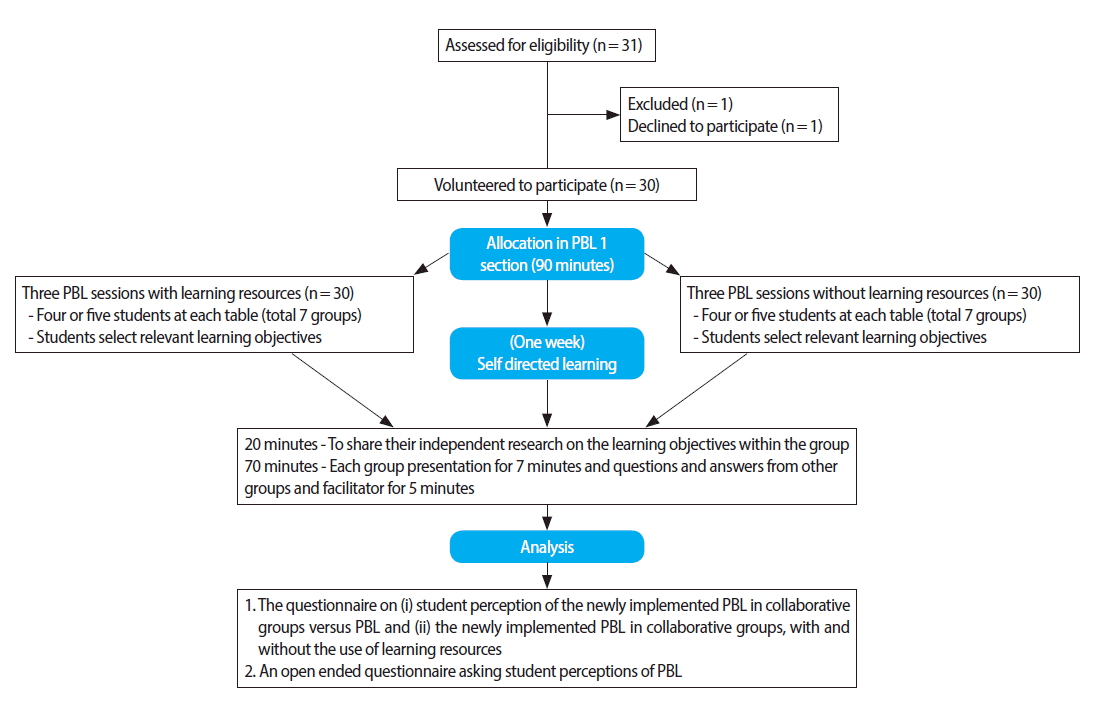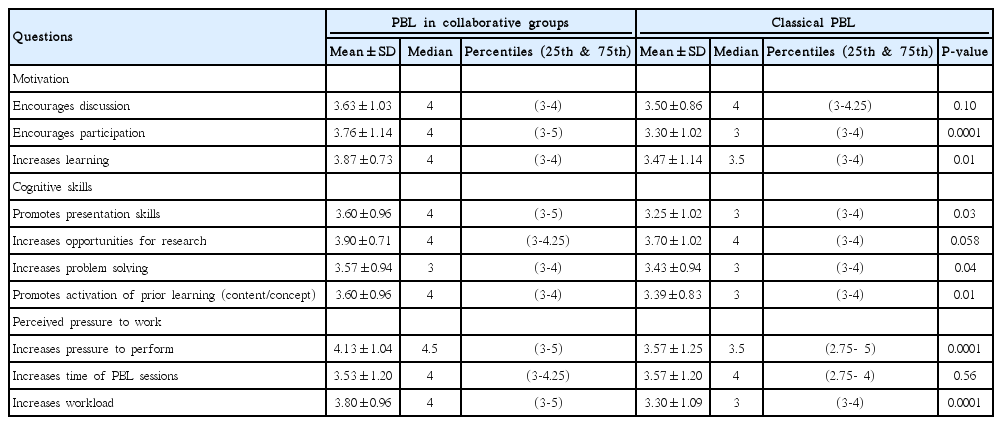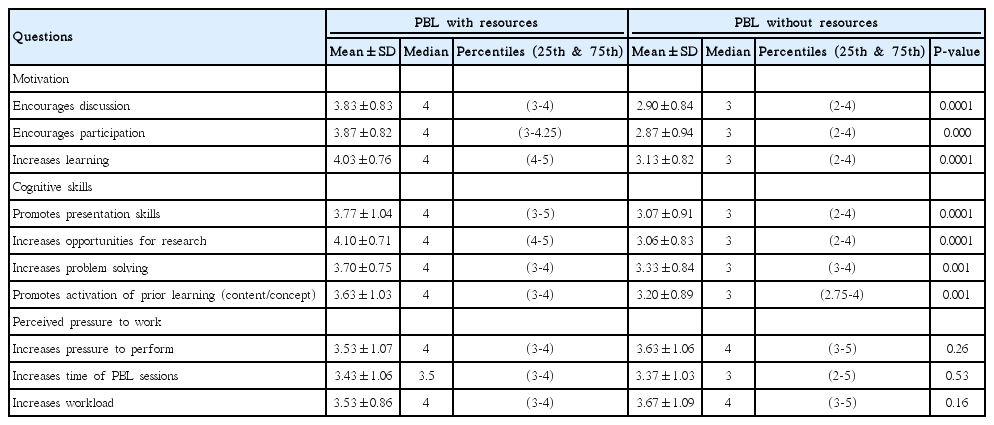The implementation of problem-based learning in collaborative groups in a chiropractic program in Malaysia
Article information
Abstract
Purpose:
Problem-based learning (PBL) is usually conducted in small-group learning sessions with approximately eight students per facilitator. In this study, we implemented a modified version of PBL involving collaborative groups in an undergraduate chiropractic program and assessed its pedagogical effectiveness.
Methods:
This study was conducted at the International Medical University, Kuala Lumpur, Malaysia, and involved the 2012 chiropractic student cohort. Six PBL cases were provided to chiropractic students, consisting of three PBL cases for which learning resources were provided and another three PBL cases for which learning resources were not provided. Group discussions were not continuously supervised, since only one facilitator was present. The students’ perceptions of PBL in collaborative groups were assessed with a questionnaire that was divided into three domains: motivation, cognitive skills, and perceived pressure to work.
Results:
Thirty of the 31 students (97%) participated in the study. PBL in collaborative groups was significantly associated with positive responses regarding students’ motivation, cognitive skills, and perceived pressure to work (P<0.05). The students felt that PBL with learning resources increased motivation and cognitive skills (P<0.001).
Conclusion:
The new PBL implementation described in this study does not require additional instructors or any additional funding. When implemented in a classroom setting, it has pedagogical benefits equivalent to those of small-group sessions. Our findings also suggest that students rely significantly on available learning resources.
INTRODUCTION
Problem-based learning (PBL) has been implemented in many universities worldwide since it was first developed at McMaster University in Canada. PBL is usually conducted as a small-group learning session with eight to ten students per facilitator and involves significant evaluation. The effective implementation of PBL has the following requirements: motivated and well-trained faculty to take on the role of facilitator, the presence of available rooms, and the willingness to invest time into the implementation of PBL sessions [1]. Motivated by the lack of some of the above prerequisites, we propose an alternative implementation of PBL in collaborative groups for programs that may lack resources such as trained instructors and PBL rooms. In this method, students are divided into groups of four or five students per table and arranged in separate groups in a seminar room. Moreover, we gave students the opportunity to participate in PBL with and without learning resources, in order to determine the effect of the availability of learning resources on student learning. The aim of this study was to determine the effectiveness of PBL in collaborative groups, both with and without available learning resources, on student learning, as assessed by a questionnaire dealing with motivation, cognitive skills, and perceived pressure to work.
METHODS
This study was approved by the International Medical University Centre of Education Ethics Committee Innovative Medical Education grant registry number: ILTIR 13/1). Six PBL cases were presented. In three of the PBL cases, students had access to learning resources, while in the other three PBL cases, they did not. PBL was conducted during the fourth semester of instruction, among sophomore chiropractic students. Each PBL session, with and without available learning resources, was conducted by the same facilitator. A total of three facilitators conducted all six PBL sessions, and each facilitator was invited to share their views about the quality of the PBL sessions via open comments. The PBL cases dealt with community health and the central nervous system.
The students had previously experienced PBL in small-group sessions involving approximately eight students per facilitator, which were conducted in the second semester of their freshmen year and consisted of six PBL cases evenly distributed between microbiology, parasitology, and immunology. During the third semester of instruction (in their sophomore year), they experienced two PBL cases involving the musculoskeletal system. In both of the PBL sessions described in this study, the students were divided into groups of four or five students per table. Thirty students voluntarily participated in this study. In the first PBL session (PBL 1), the PBL case was divided into three components, involving the presentation of a clinical trigger related to the PBL case, following the format of the previous PBL sessions in the second and third semesters of instruction. Each session took 90 minutes, and the students spent the first 60 minutes formulating their learning objectives. At the beginning of the PBL session, the first part of the case was distributed, and the students were asked to work within their assigned groups to assess the presented information, to list various concerns and problems, to hypothesize what might be happening, and to identify issues that could not be addressed without further study. Approximately 15.20 minutes were allotted for each part of the initial discussion. Group discussions were not continuously supervised, since only one facilitator was present. However, the facilitator helped students to accurately assess the relevant learning objectives. During the last 30 minutes, students in each group were asked to write down their learning objectives on the white board. The entire class then discussed similarities and differences in the learning objectives and the issues that they might have missed. Finally, with the help of the facilitator, the students selected the most effective and relevant learning objectives for research and discussion in the second PBL session (PBL 2). Five to seven learning objectives were generally identified per topic. PBL 2 was conducted a week later and took 90 minutes. The groups were initially given 15.20 minutes to share their independent research on the learning objectives that they identified in the previous session and to propose a hypothesis based on the information they had gathered. A group representative presented one learning objective that was randomly selected by the facilitator. Groups were allowed to use multimedia equipment. Each group presented for seven minutes, and then five minutes were allocated for other groups to ask questions. A summary of the study protocol and the new implementation of PBL in collaborative groups is presented in Fig. 1.

The study protocol and workflow of problem-based learning (PBL) in collaborative groups among chiropractic students in 2012 at the International Medical University, Kuala Lumpur, Malaysia.
The students’ perceptions of PBL in collaborative groups were assessed by a questionnaire including Likert-scale items and open-ended items. The questionnaire was piloted with previous chiropractic students for content validation. The responses were scored using a five-point Likert scale, where 1= strongly disagree, 2=disagree, 3=somewhat agree, 4=agree, and 5=strongly agree. Based on an a priori scale, items in the questionnaire were further categorized into the domains of motivation, cognitive skills, and perceived pressure to work. We compared students’ perceptions of PBL in collaborative groups with their perceptions of classical PBL. We also assessed how students’ perceptions varied depending on the availability of learning resources. An open-ended questionnaire evaluated students’ perceptions before and after participating in PBL in collaborative groups. The questionnaire included questions about the strengths and weaknesses of PBL, as well as the skills that can be learned from PBL.
SPSS software (version 18.0, SPSS Inc., Chicago, IL, USA) was used for statistical analysis. Cronbach’s alpha coefficient was used to assess the reliability of the questionnaire. For each question, the mean score, median score, and percentiles were identified. In the data reflecting students’ perceptions of PBL, the answers of individual students to the same questions pertaining to classical PBL versus the new PBL system were collected, and differences in the students’ answers were assessed by the Wilcoxon rank-sum test. P-values<0.05 were considered to indicate statistical significance.
RESULTS
Students’ perceptions of PBL in collaborative groups
Table 1 shows the data obtained from the questionnaire concerning the students’ perceptions of PBL in small groups. The items in the questionnaire were grouped into three main domains: motivation, cognitive skills, and perceived pressure to work. The Cronbach’s alpha coefficient was >0.9 among items within each domain of the questionnaire. Significant differences were found in the motivation domain, indicating that PBL in collaborative groups encourages participation and increases learning. Significant differences were also found in the cognitive skills domain, indicating that PBL in collaborative groups promotes presentation skills, the activation of prior learning, and problem-solving skills. Significant differences were found with regard to perceived pressure to work, indicating that PBL in collaborative groups increases the perceived pressure to perform and leads to a heavier workload.
Students’ perceptions of PBL in collaborative groups with and without available learning resources
Students were given the opportunity to discuss the case with or without available learning resources in PBL 1. Depending on this choice, significant differences were observed in response to questions dealing with motivation and cognitive skills. The students showed a preference for using resources during PBL 1; however, no significant difference was observed in questions assessing perceived pressure to work (Table 2).
Students’ feedback in open-ended questions
Table 3 shows the students’ answers to four questions evaluating their perceptions of PBL before and after the PBL sessions. A total of 23 students (74%) answered the open-ended part of the questionnaire. In the pre-PBL questionnaire, 69.6% of the students expressed a desire to have more PBL sessions in the future, compared to 65.2% in the post-PBL questionnaire. Communication skills and skills involving the utilization of learning resources were the top two skills that the students wanted to learn before participating in PBL. Communications skills and teamwork skills were the top two skills that the students identified as having been improved by participating in PBL in collaborative groups. In response to the pre-PBL questions concerning the strengths of PBL, the most common comment was that PBL made the students seek out more resources and understand the material better (43.5%). Among the students’ post-PBL comments, 91.3% of students wrote that PBL led them to engage in discussions, interact with each other, and better understand the content. In response to questions concerning the weaknesses of PBL, the most common comment was that too much time was needed for research; this response was observed in both the pre- and post-PBL questionnaires.
Facilitators’ feedback on PBL in collaborative groups
The lecturers involved as facilitators were asked to provide feedback on PBL in collaborative groups. One facilitator commented that a single instructor can manage many small groups of students in a lecture hall while conducting PBL in collaborative groups. This facilitator also felt that this style of implementing PBL made efficient use of time, space, and manpower. Another facilitator had similar comments, and suggested that PBL training should be expanded and modified to accommodate large-group facilitation skills in order to implement PBL more effectively across other modules and programs in the university. The third facilitator felt that students interacted more productively in groups of four to five than in the previous format that involved groups of 8.10 students, as each student was more engaged in the discussion process. This facilitator also noted it was quite tiring to move among groups in PBL 1, as the students were at various stages of discussion; however, this was a minor concern.
DISCUSSION
PBL in collaborative groups was conducted as an alternative method to improve student learning of concepts related to the community medicine and central nervous system modules, similarly to small-group PBL sessions. A significant result of this study is that PBL in collaborative groups leads to increased motivation, use of cognitive skills, and perceived pressure to work among students. These findings are probably due to the small group size of four to five students, in which every student has a better opportunity to interact with each other. In a study similar to ours but related to nursing education, PBL was conducted in a large classroom with one faculty tutor. In that study, students and tutors met in the classroom once a week for three hours over a period of two weeks, while communicating via course web site positing in the meantime. The authors reported that this PBL format enhanced communication skills and encouraged more active participation in the learning process. A major difference between our study and the previous study is that the students in the previous study had no prior experience with PBL, whereas the students in our study did [2].
There are some barriers to conducting PBL in large classrooms such as lecture halls, because such rooms are not ideal for team-based activities if the chairs are fixed and face in one direction, leading to the possibility of one facilitator losing control of many groups and the risk of excessive noise from many groups discussing cases at the same time, according to Nicholl and Lou [1]. However, both our study and Nicholl and Lou’s study showed that experienced and qualified facilitators effectively managed those barriers, because students were divided into groups in an open space rather than being spread out in a lecture hall. Furthermore, students were found to speak more quietly to avoid disturbing other teams, thereby showing professional behavior during the process. The seminar rooms used in our study were equipped with movable chairs, which could be arranged to allow students to sit face-to-face in small groups.
We have found that access to learning resources can promote success in PBL sessions and that the integration of PBL and learning resources is important for student learning. The success of PBL depends both on the facilitator’s experience and knowledge and on the students’ motivation. It can be difficult to standardize the learning outcomes associated with PBL sessions. Although informal, the feedback provided by the three facilitators in our study was useful, in that it highlighted the willingness of facilitators to participate in PBL in collaborative groups.
Some drawbacks to this PBL method were noted in the open-ended questions. For example, the students suggested that the weaknesses of PBL included the necessity of spending an excessive amount of time consulting the learning resources. However; PBL aims to develop independent and active learning skills, and it is necessary to allocate time for research, because it is part of the learning process. While students did not allude to this point, the literature suggests there are some disadvantages involved in facilitator-less PBL sessions. Some of these disadvantages may occur in PBL in collaborative groups, as the facilitator does not remain with a single group during the entire session. In such an environment, students may take shortcuts or skip elements of the PBL learning process [3].
In conclusion, PBL in collaborative groups does not require additional instructors, learning spaces, or funding; hence, it could be expanded further as a learning tool within chiropractic programs or other health education programs. According to the above results, this method of implementing PBL has benefits for students’ learning that are similar to classical PBL, although not necessarily better.
Notes
No potential conflict of interest relevant to the study was reported.
Acknowledgements
This study was supported by Innovative Medical Education grant registry number ILTIR 13/1 of the International Medical University, Kuala Lumpur, Malaysia.
SUPPLEMENTARY MATERIAL
Audio recording of the abstract.



